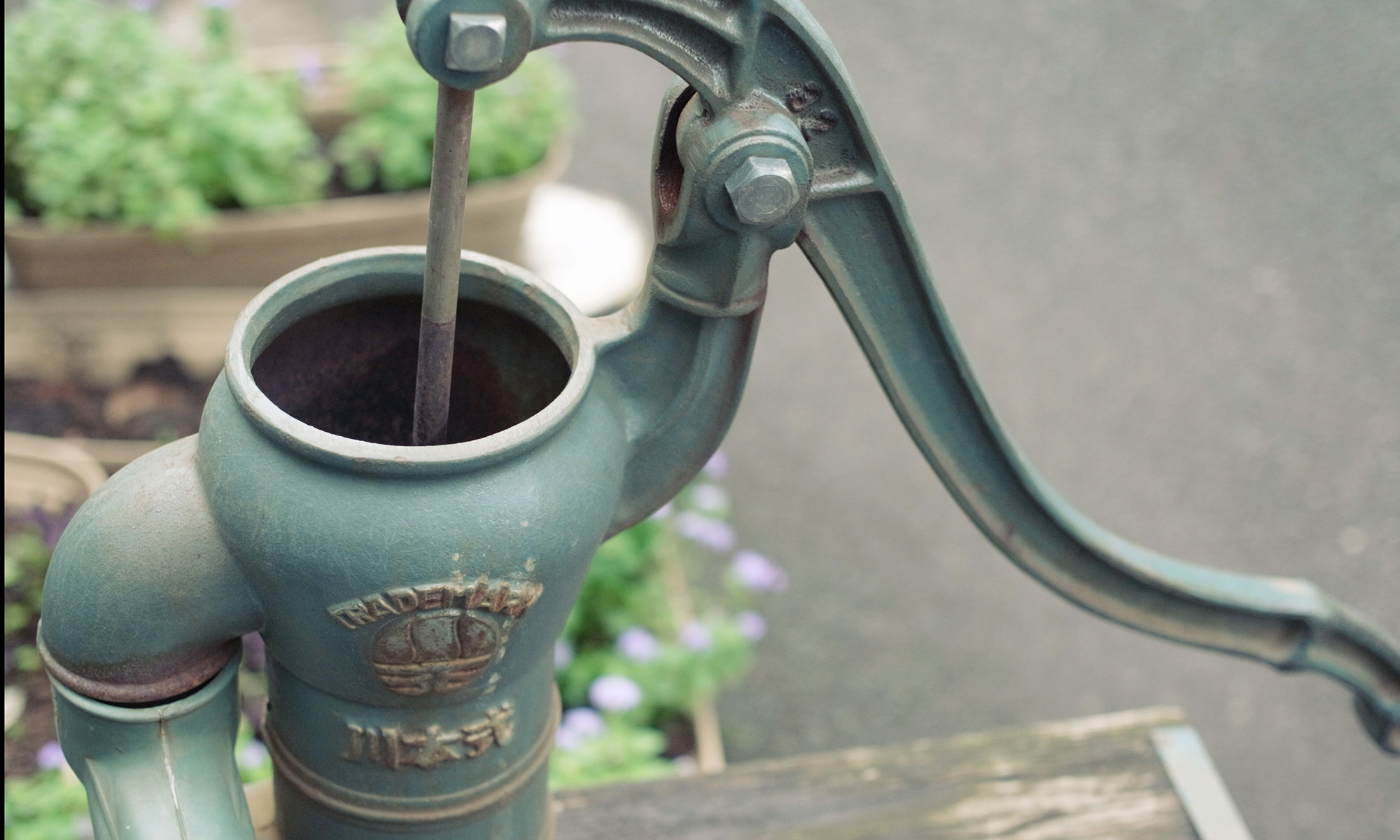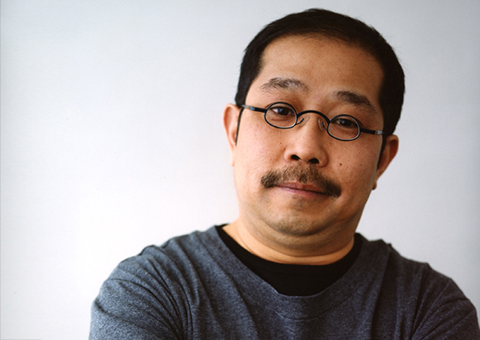
すべての建築は道から進化した
All Buildings Have Evolved from Roads.

井戸端会議という言葉があるけれど、たとえば、東京上野のあたりに行くと、通り道の一角が井戸を中心にして、ちょっと広くなっているところが、今でも残っている。まわりの住まいから、飲み水、炊事、洗濯、行水のための水を汲みに、おかみさんたちが、三々五々出てきて、世間話や噂話に興じる。そんな光景が見受けられたのも、けっして大昔のことではない。
日本には、もともと「広場」はなかった。そのかわり、「辻」と呼ばれる都市空間があったと言う。辻とは、十字路のことであり、あるいは往来の多い通りのことだ。辻では、行商人たちが品々を並べ、香具師たちが見世物などの芸を披露していた。江戸時代には、歯の民間治療をする「辻医者」なる者もいたとも言う。
こういうことを聞くと、ぼくなどは、昔の道はずいぶんと豊かなものだったのだなあ、と感慨にふけってしまう。目を閉じれば、路傍に店を広げて座っているおばあさん、それを冷やかすおかみさん連中、扇子を持って舞う少年、酒杯をあげる髭の老人、念仏風流に興じる老若男女が見えてくる。行き交う人がいるから商いが始まり、商いがあるから往来が増える。一日のうち、かなりの時間を過ごす生活の場、それが道だったのだ。
そういう道から、時代が下るに連れ、いろいろな楽しみが失われていく。そして、とうとう交通の用途だけ、というところまでやせ細ってしまったのが現代の道路。
道が貧しくなったのと反比例して豊かになったのは、沿道に建ち並ぶ建築、と言われる。商売のためには店舗が、酒宴のためには居酒屋が、観劇のためには劇場が、踊りのためにはクラブが、さまざまな趣向を凝らしてつくられる。しかし、そういう建築も、実は、特定の目的を合理的に達成するという点は便利だけれど、それはつまり、機械装置の優秀にすぎない。けっして、人間にとってうれしいものではなくなっている。
この光景は、まるで、いろんな風合いを含んでパンパンに充実していた道が、ぎゅっと絞られ、エキスが抽出されたよう。エキスを抜かれた道はすでに出し殻で、しかも、エキスの方とて純粋すぎて、それではちっとも楽しくない。
いろいろなものが、手段と目的に分かれていく。道からそこでの楽しみが分離され、それが建築物として固定される。かつて道がもっていたふくらみが、目的地となって独立する。残った道は、その目的地に至る手段に成り下がってしまった。
建築の中身も、手段と目的に分かれていく。部屋は、必要諸室と呼ばれ、建築の目的と認知される。そして、それ以外の空間の面積はできるかぎり縮減される。なぜなら、それらの空間は、建築の目的ではなく、目的の空間と空間をつなぐ手段に過ぎないからだ。手段となった空間とは、廊下であり、階段であり、エレベータだ。つまり、建築のなかの「道」の部分。
それで、20年前、建築家として仕事をはじめたとき、ぼくは、今の道ではなく、かつての道をモデルにして建築を設計しようと考えた。あらかじめの目的があって、それを効率よく達成する生活ではなく、とりあえずなにかしているなかから、楽しいことが生まれていく生活。かつての道のような、そんな空間を目指そうとしたのだ。そうしてまずぼくは、部屋を持たない、廊下や階段といった動線だけから成る建築を構想しはじめた。どうやったら、その動線が膨らんで、そこから動線以上のものが生まれることができるのだろうか。「すべての建築は道から進化した。」それは、ぼくが立てた最初の仮説だったのだ。
Just as in Japanese we have the phrase “gossiping around the well,” even now you can find such scenes in wider areas of roads centered on wells in the area of Ueno in Tokyo. Housewives come out in small groups to draw water for drinking, for cooking, for laundry or for bathing and chat about any and everything. It wasn’t so long ago since such scenes were commonly seen.
Japan has always lacked wide open spaces. Instead, it has such urban spaces as tsuji, or rather crossroads. This word can refer to a four-way intersection or to a road with heavy traffic. At such places would traders place their goods for sale and street stall vendors ply their trade. In the Edo period (1603-1868) there were even crossroad doctors who would offer treatment for people’s teeth.
Hearing such stories make us feel strongly just how lively were those roads of long ago. If I close my eyes, I can see old women sitting in shops lining the road and the groups of housewives bantering away with them, youths dancing with fans, bearded old men raising glasse of sake, young and old, men and women alike happily engaged in festive dancing. Where people meet commerce develops, and where commerce develops traffic increases still further. Roads were a place where people lived out a good part of their daily lives.
As the years passed, roads have gradually lost those enjoyable things. Our roads now have thinned out to become means of transport alone.
It has been said that as roads have faded into obscurity, the shops that line them have become all the brighter. They have elaborated themselves into shops for business, restaurants or bars for eating and drinking, theaters for plays and clubs for dancing. But while these buildings are perfectly suited to meeting a specific purpose, their advantages are as such purely mechanical. They are not in fact places pleasurable to humans.
It is as if the roads of long ago, full of such variety and life, have been squeezed to extract only their essences. The roads are left as dried out carcasses, while the extracted essences are too pure in value to be enjoyed as they are in any way.
Variety is split into means and ends. The pleasures to be found on the road are divided up and fixed into place as buildings. Wide roads have had their edges carved up into independent destinations. What remains of the roads is just a means to reach those destinations.
The interiors of buildings are also split into means and ends. Rooms have become the primary focus as the ends for which buildings are constructed. The amount of floor space given over to other spaces is limited as far as possible. The reason is because such spaces are not part of the purpose of the building – they are just means to join the ends (the rooms). Examples of such means are corridors, stairs or elevators – in fact, the “roads” inside buildings.
Over twenty years ago, when I had first started out as an architect, I wanted to design buildings with those long-ago roads as a model. Such a lifestyle would see pleasure arise from what you happen to be doing at the moment, rather than seek efficiency from preset objectives. My idea was to aim at such a lifestyle, just like those roads of long ago. I began then to plan out a building founded upon paths made up by corridors and stairs rather than rooms. Would it be possible for those routes to expand out and form something beyond themselves? “All buildings have their beginning in roads.” This is the first thesis I came up with.
青木淳(建築家)
磯崎新アトリエに勤務後、青木淳建築計画事務所を設立。作品は住宅、公共建築、ルイ・ヴィトンの店舗に代表される商業施設など多岐に渡る。代表作に「馬見原橋」「潟博物館」「青森県立美術館」がある。
Jun Aoki (Architect)
Architect. After working for Arata Isozaki & Associates, he established his own architectural office, Jun Aoki & Associates. His works cover a wide scope, from houses and public buildings to commercial facilities such as shops for Louis Vuitton. Some of his key works are the Mamihara Bridge, the Fukushima Lagoon Museum and the Aomori Museum of Art.
